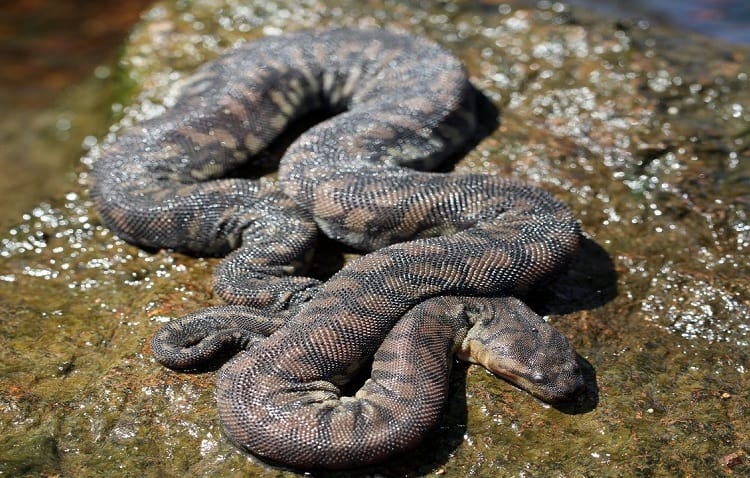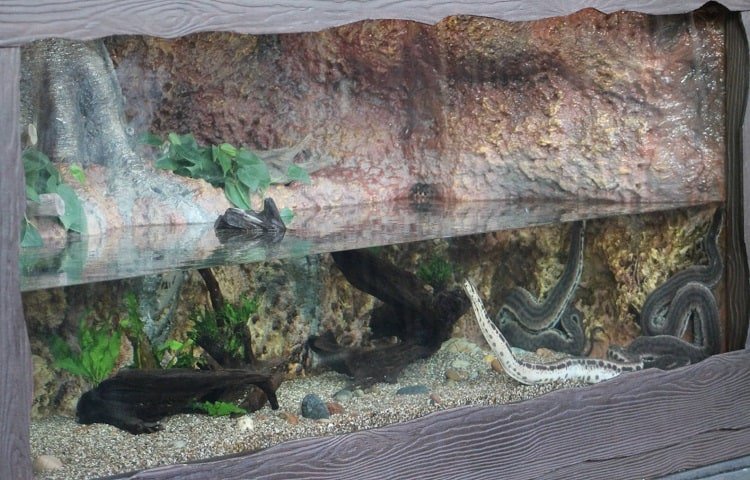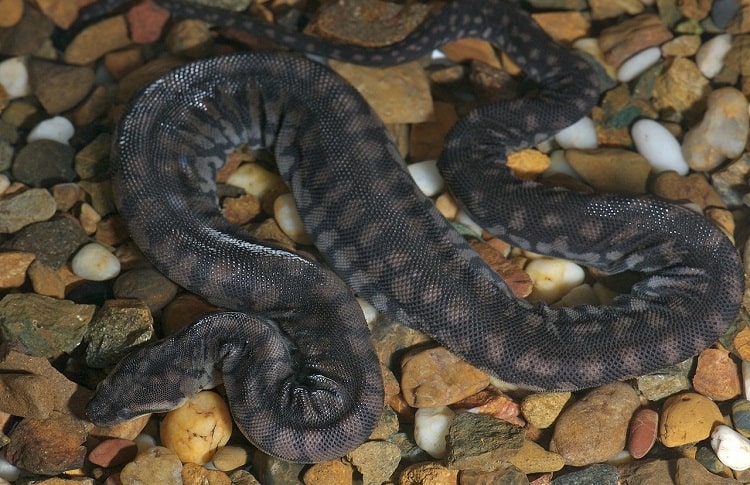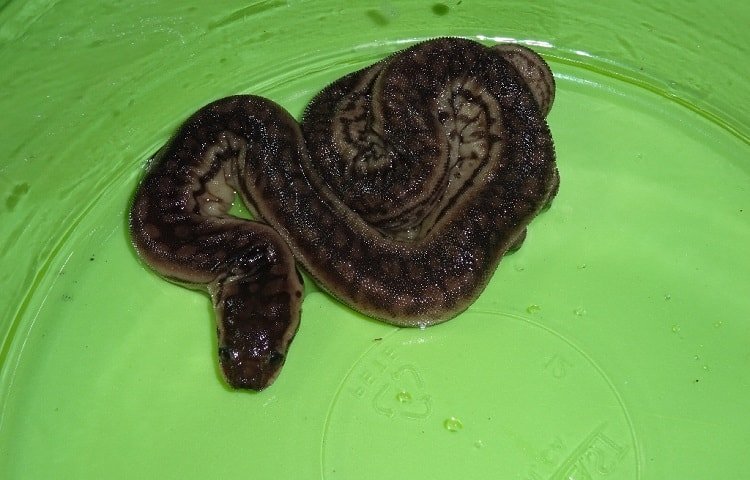
Don’t.
That’s probably not what you want to hear, but most people should not own this snake.
It is incredible difficult to look after.
It is shy and easily stressed out and has very specific requirements. It also grows quite large.
Unless you have the space for a large snake and you are able to provide the exact environmental conditions this species needs, you should not have one as a pet.
What are the snake’s requirements?
Keep reading to find out. We’ll start with some general info on the elephant trunk snake, then examine what it takes to care for one.
Table of Contents
Elephant Trunk Snake Size And Appearance
The elephant trunk snake, otherwise known as Acrochordus javanicus, hails from Northern Sumatra and the west coast of Malaysia. It lingers around lagoons and other bodies of water.
Because it spends most of its time underwater, it should come as no surprise that it loves to eat fish.
This snake has loose skin with small, rough scales that have triangular ridges on their surface. This gives the snake a very unique appearance.

The elephant trunk snake can grow large. It reaches sizes of five to eight feet in length. The females are usually twice as long as the males.
One of the things that makes the elephant snake interesting is that it looks like a boa. The main difference between the two is that the elephant snake’s body and head are the same width.
These snakes are brown in color with yellow bellies, and they have a pattern on them with markings that resemble warts. This can make for some funny names for this snake.
Their loose skin is quite strange-looking. It appears as if the snake is too small for its covering. But this skin serves an important purpose. It helps to strengthen the snake’s grip when it catches prey!
Elephant Trunk Snake Care
If you really want to own an elephant trunk snake, you need to commit to making their habitat as similar as possible to what they’d find in their natural environment.
The elephant trunk snake is a water-loving snake that spends most of its time in the water. Amazingly, these snakes can spend 40 minutes underwater, without coming up for air!
When their lungs need fresh air, they will align their bodies with the water surface so that their nostrils are exposed for 20 seconds.
Let’s look at what you’ll need to do to properly care for an elephant trunk snake. We’ll begin with the enclosure.
Elephant Trunk Snake Enclosure

The elephant trunk snake needs a large enclosure with a watery environment. If your snake is young and under 20 inches in length, you can house it in a 15 gallon enclosure.
But know that you will have to upgrade shortly. Larger snakes need tanks that have a minimum capacity of 150 gallons. More is better, to give your snake plenty of room to feel comfortable.
Fill the tank three-quarters of the way with dechlorinated water. This allows the snake to swim to the surface when it needs fresh air.
Place a water heater in the bottom of the tank so that the water is the ideal temperature. It should be 84° to 86° Fahrenheit.
Since you want your snake to feel comfortable, you want to give it places to hide and feel protected. Add some hides to the water that won’t float to the top. Good examples include ceramic pots and wood.
It’s also a good idea to place some aquatic plants in the tank. This will help the snake to feel more at home. If you don’t have real ones, fake plants work just as well.
These snakes are excellent escape artists, so you need to put a mesh screen on top of the tank.
Since these snakes are prone to health conditions, like white spot fungus, you need to ensure that the water is filtered and always at the correct temperature. The water also needs to be slightly acidic, with a pH level of 5.5.
You also need to add tannins to the water. These not only prevent bacteria from growing in the water, but they give it a cloudy brown appearance that mimics the snake’s real aquatic environment. It also helps the snake feel less exposed.
You don’t need substrate at the bottom of the tank. This snake doesn’t need it and it’s difficult to clean. Simply place rocks and stones at the bottom of the tank instead.
These snakes are nocturnal, but they do need 12 hours of light every day. You can simply use indirect sunlight, if the daylight hours are long enough. Alternatively, you can use a UVB lamp.
Feeding Your Elephant Trunk Snake

These snakes like a diet that’s rich in fish and amphibians. You can feed them a variety of fish. They don’t have a specific preference.
Some even eat dead fish. Good things to feed your elephant trunk snake are mollies, guppies, shiners, tinfoil barbs, and minnows.
How you feed your elephant trunk snake is important. You won’t be able to hand it food the way you might do with other snakes.
These snakes are very shy, so you should place the food in their water and then leave the room, so that they can eat on their own. You don’t want them to feel like you’re invading their space.
These snakes sometimes leave their food in their tanks for a while before eating it. This is as a result of their shy nature, but it can also be due to their hunting methods.
The elephant trunk snake has a fascinating way of hunting prey.
It locates fish in the water and then wraps its body around it, before swallowing the fish alive. Its sharp scales help it to keep the fish in place and prevent it from squirming out of its grasp.
Common Health Conditions

It helps to be prepared for the types of health conditions that can affect your Elephant Trunk snake. One of the biggest problems they face is white spot fungus, which shows up on the snake’s skin as little white spots.
The primary reason for this condition is that these snakes are usually caught wild. Many are sadly kept in bad conditions before they are traded and this results in them being put through a lot of stress.
You might find that the elephant trunk snake you have bought already has this fungus.
If not, you can prevent white spot fungus by ensuring proper husbandry for your snake. Monitor pH and temperature levels in the enclosure and make sure they stay where they should be.
To treat this fungus, you can use commercial fungus treatments. But many times, proper care when it comes to the snake’s environment is all that’s required to bring your unique pet back to health.
Related Questions
Is the elephant trunk snake venomous?
This snake is not venomous, but it can cause serious injury to its prey, thanks to its teeth. They are curved and will remain stuck in its victims flesh when it bites. It will bite underwater.
Does the elephant trunk snake like being handled?
No, and you should avoid doing this unless absolutely necessary. Regular handling causes them stress. These animals need water to survive. Being taken out of their watery environment can also cause them severe injuries.
What’s the banded elephant trunk snake?
This is a morph of the elephant trunk snake, and it’s really eye-catching. As its name suggests, it has a dark-colored body and bands of yellow or beige all along its length.
Elephant Trunk Snake: Conclusion
We strongly discourage any beginning snake owner from getting an elephant trunk snake as a pet.
These creatures require lots of care and have specific requirements for their enclosures and food. They also grow very large.
If you are an experienced snake owner and you are certain you can provide this snake everything it needs, then owning it might make sense. But you need to be absolutely certain you know what you’re getting yourself into, so make sure to do thorough research,
Leave a Reply